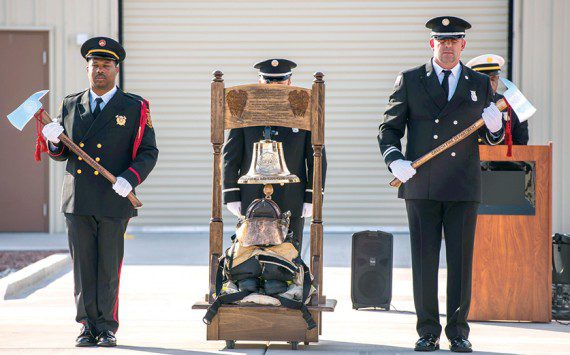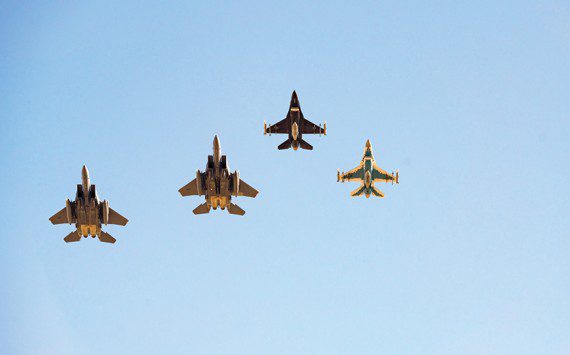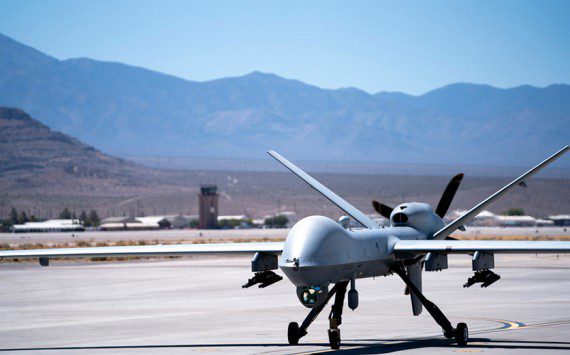Staff Sgt. Robert Mackle, 95th Aircraft Maintenance Unit crew chief from Tyndall Air Force Base, Fla., waits for the arrival of an F-22 Raptor pilot during Red Flag 16-1, Jan. 28, at Nellis AFB, Nev. Aircraft maintainers from around the world ensure the mission is executed safely and efficiently during the three-week exercise.
NELLIS AIR FORCE BASE, Nev. — It is a given that no aircraft leaves the ground unless it is working properly, but that challenge is multiplied here at Red Flag 16-1. Hundreds of maintainers from around the world work long hours to ensure all training sorties are executed safely and efficiently.
Maintainers are the lifeblood of the flightline, and with almost 80 planes taking off twice daily during Red Flag, they have their work cut out for them. It is their duty to keep everything running safely and ensure every mission essential aircraft leaves the ground and returns in one piece.
“Anytime we take aircraft on the road we face challenges because we’re away from our facilities and our normal lanes for parts and supplies,” said Capt. Matthew Goldey, 95th Aircraft Maintenance Unit officer in charge, Tyndall Air Force Base, Florida. “This is pretty accurate to what you would see downrange. This is about as real as it gets and this is how we fight.”
Red Flag 16-1’s training is centered on readiness through completing combat-realistic missions in a degraded and operationally limited environment. Despite these challenges, the participating maintainers are managing to come together as a team and taking care of business and each other.
“There is no one out here saying, ‘that’s not my job.’ Instead it’s, ‘What do you need? Okay, let’s get it done. This is broke? Okay, let’s fix it.’” said Master Sgt. Marc Neubert, 325th Aircraft Maintenance Squadron first sergeant from Tyndall AFB. “That is one of the coolest things that I have seen so far.”
Red Flag brings diverse air, space and cyber units and countries together from all over the world and across the services. But the one thing they all have in common is the need for experienced maintainers to take care of their fleets.
“It’s a satisfying feeling to know that I’m part of a bigger picture and that I am making a difference,” said U.S. Navy Petty Officer 3rd Class Christian Gonzalez, VAQ-138 plane captain, Naval Air Station Whidbey Island, Washington. “I’m really enjoying learning the way the different branches do their maintenance and it’s very interesting to see the different aircraft.”
Total force integration is a key component of training during Red Flag 16-1.
Capt. Goldey, is a U.S. Air Force reserve officer from the 44th Fighter Group, Tyndall AFB but during the exercise, he is imbedded in the 95th AMU as the officer in charge.
Senior Airman Steven Brinley, 95th Aircraft Maintenance Unit crew chief, Tyndall Air Force Base, Fla., inspects an F-22 Raptor during Red Flag 16-1, Jan. 28, at Nellis AFB, Nev. Maintainers are the lifeblood of the flightline, and with almost 80 planes taking off twice daily during Red Flag, it is their duty to ensure mission-essential aircraft leave and return safely.
“We are one unit, and totally integrated,” Goldey said. “There is no us and them anymore. We’re all one team. We all wear the same uniform and we’re all out here to accomplish the same mission.”
A problem arises as active duty Airmen rotate out from a base and new ones come in, there is a loss of knowledge and continuity. Through total force integration the U.S. Air Force can elevate that problem by having an Air Force Reservists and Air National Guardsmen.
“A TFI unit brings continuity to the active duty force,” Goldey said. “Being in the Reserve you have the opportunity to stay at a particular location longer than most active-duty members so we bring some continuity and experience to the fight.”
While most maintainers are not working directly with the other units outside their organization, Airmen refueling aircraft for the exercise are the exception. Fuels augmentees work with most of the units on the flightline.
“We have really good comradery with everyone,” said Airman 1st Class Alexis Aragon, 7th Logistics Readiness Squadron fuels specialist, Dyess AFB, Texas. “Fuels is the lifeline of every aircraft, and without fuel these aircraft can’t go anywhere. I love it because I know we’re helping get the mission done, and I’m glad we augmentees could come out here from different bases to help do that.”
During exercises like Red Flag, the maintainers are able to shed any weight they may carry during normal operations at their home base, like special duties and office work, and just concentrate on their main objectives.
“Our Airmen are ‘killing it’ right now,” Goldey said. “Out here it’s total mission focus. Out here it’s just about putting planes in the air. Anytime you get an opportunity to do that, it is great.”
With the collaboration between military branches and multiple units from around the world along with the total force integration, the maintainers of Red Flag 16-1 know they have an entire flightline backing them up.
“I have learned here that you have to support one another,” said Staff Sgt. Matthew Brown, 44th Fighter Group weapons loader form Tyndall. “You have to consistently do what you can to make sure everyone gets what they need to accomplish the mission.”














